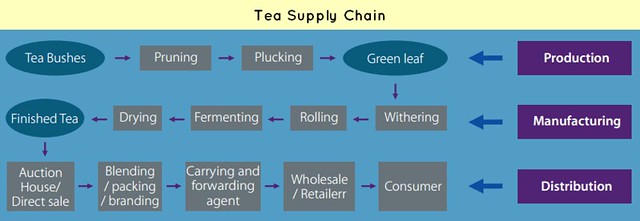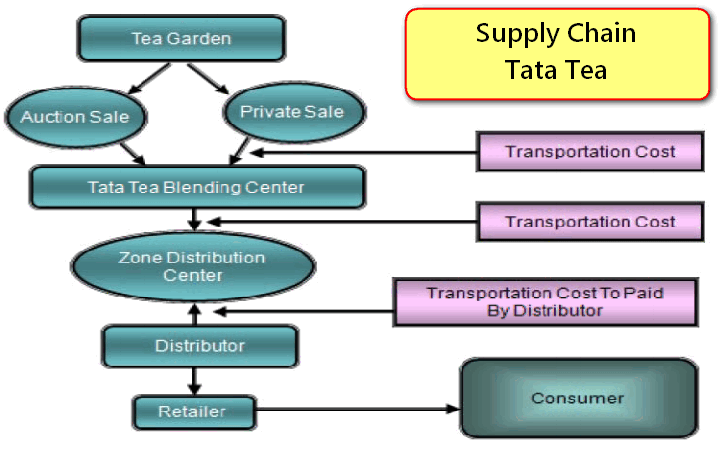Prologue
- Although I had planned this to be the last article under [Food processing] but heavy-rainfall in Gujarat randomly shutting down my landline internet and electricity, hence couldn’t work on edible oil, bread-biscuit etc. topics. They’ll be published later on.
- This one covers only tea and coffee. Meaning one more article to go before ‘The end’ of [Food Processing] series.
Tea: Scope Significance
| India’s rank | in world (2012, as per Teaboard) |
| production | 2 |
| consumption | 2 |
| export | 4 |
- Provides employment to more than 50,000 workers around Darjeeling alone and overall ~5 lakh tea-farmers
- Brings ~4000 crore rupees through export.
Location
| REGION | TEA SEASON |
| North: Assam, West Bengal | March-December. |
| South: Tamil Nadu and Kerala | throughout the year |
- main states: Assam, WB, TN and Kerala
- small scale: Karnataka, Tripura, HP, Uttarakhand, Arunanchal, Manipur, Sikkim, Nagaland, Meghalaya, Mizoram, Bihar and Orissa.
For more on location factors: refer the [Geography] article click me
Tea Supply Chain: Upstream
Old bushes=low yield
- A tea plant is most productive between 15 and 35 years of its planting.
- Yields of tea usually drop after 50 years. Tea gardens in Darjeeling are about 80-100 years old.
- In Kerala, around 80 % of the tea bushes are over 40 years old
- Result? = low yields and deterioration in tea quality= low prices in foreign market.
Solutions?
- Need to upgrade Tea estates through replanting, uprooting and cloning of high yielding varieties.
- But these solutions are expensive and time consuming.
- Therefore most tea estates prefer to maintain status quo. Thus production keeps declining with each year.
| Land Ceiling Act |
|
| Collectivization |
|
High labour costs
As per The Plantation Labour Act 1951, Tea companies need to
| provision under Plantation Labour Act | implication for the tea estate owner |
| Maintain a minimum number of employees pay certain minimum wages | Salaries alone account for ~55% of operation cost (way higher than Vietnam / Argentina) |
| Provide other amenities to workers (housing, school etc) | High cost of labour welfare. (compared to Sri lanka, Kenya) |
Thus plantation labor act increases cost of production. Hence, tea estate can’t afford replantation/cloning=lower yields every year.
let’s look at some more negative factors
| RAINFALL |
|
| FERTILITY |
|
| POLLUTION |
|
| ROADS |
|
| LAND MAFIA |
|
Taxation
| TAX | tea plantation is subjected to |
| CENTER |
|
| STATE |
|
- Unbranded, loose tea manufacturers at local level- they are not required to pay any taxes/excise duty/corporate tax or any other state-level levies.
- This leads to MRP price difference between branded and unbranded tea.
Branded Tea players see less demand= stretched financial condition= again, can’t invest replantation of tea shrubs.
Bought leaf factories
- Bought leaf factories (BLF) have their own independent tea processing units
- But they donot own tea plantations, they procure leaf from small growers via auction centers.
- BLF factories are not subject to the plantation labour act or agricultural tax=> their operation cost is lower than tea estates.
Exit
- Initially, the fast-moving consumer goods (FMCG) companies like Tata tea and Hindustan Unilever bought tea plantations in Assam and Tamilnadu to bring down the cost of raw material.
- but both had negative experience due to ^above Upstream issues, so by 2005, they sold away plantations to former employees and other companies.
- Now Tata and Hindustan Unilever focus on blending, packaging and marketing only.
Tea Auction
- About 50% of world production continues to be traded via the auction mechanism.
- Auction centres are located at all major producing countries, with the exception of China.
- In India, Tea Auction centres located at Guwahati, Siliguri, Cochin, Calcutta, Coonoor, Coimbatore and Amritsar.
- Guwahati = largest CTC tea auction centre in the world.
- Problem:= in auction, the brokers gulp down majority share. tea producer doesn’t get fair share.
Tea Supply Chain: Downstream
| DESI CONSUMER |
|
| YOUTH DEMAND |
|
| PREMIUM | The premium tea (Expensive brands) = very small demand in India, not even 10% of total tea sales. |
Export related
| leading exporters | importers |
| India, Sri Lanka, Kenya, Indonesia and China. | Russian Federation, UAE, Iraq, UK and Kazakhstan |
let’s check the issues
| LOW VALUE ADDITION |
|
| KENYAN COMPETITION |
|
| Fall of USSR |
|
| TRADE AGREEMENTS |
|
The combined negative effect of all of above upstream, downstream issues can be seen in following table:
| India’s % share in world export | 1970 | 2011 |
| tea | 33% | 10% |
another table:
| 2011 | export in Rs. cr. | tea’s share in India’s export | India’s % share in world tea-export |
| tea | 4000 | less than 0.5% | 10% |
Meaning: despite favorable agro-climatic conditions and cheap manpower, tea doesn’t fetch us much export earnings.
Foreign consumer Preference
| BLACK TEA |
|
| GREEN TEA |
|
| fruit/herbal tea, oolong tea, white tea, mint, chamomile, organic tea |
|
Future strategy
- Government needs to streamline taxes, help estate owners to plant new shrubs.
- In the traditional tea-drinker Western markets (i.e. UK, Ireland, Netherlands, Australia, New Zealand) strong growth in tea-demand is unlikely. Because their younger population is shifting towards Coffee. Tea is regarded as an old-fashioned drink.
- Indian government + tea growers need to make marketing/awareness campaign about the health benefits of green/herbal/organic tea to create its demand in non-tea drinkers and youth abroad.
Tea Board of India
- Statutory body under the Ministry of Commerce.
- The Board has members drawn from Parliament, tea producers, traders, brokers, consumers, and representatives of Governments from the principal tea producing states, and trade unions.
- The Board is reconstituted every three years.
- Provides Financial and technical assistance for cultivation, manufacture and marketing of tea.
- helps plantation workers and their children through labour welfare schemes
- Darjeeling Tea is given GI-status (Geographical indicator), Tea board coordinates with foreign agencies to see that it is strictly enforced.
- Export Promotion
- Data collection, analysis, R&D etc.
Coffee: Scope/Significance
- India is a small but competitive producer of coffee
- India is the fifth largest coffee producer in the world.
- The Indian cafe business is estimated at ~1500 crore rupees, and is expected to grow at more than 10% per year.
- Plantations are eco-friendly, also provide the perfect habitat for birds.
| 2011 | export in Rs. cr. | %share in India’s export | India’s % share in world export |
| coffee | 4500 | less than 0.5% | 2% |
(Source: Economic Survey 2012)
Location
Coffee growing regions in India can be grouped under three distinct categories:
| Traditional areas |
|
| Non-traditional | Andhra Pradesh and Orissa in the Eastern Ghats. |
| North Eastern region | ’Seven Sister’ states of Assam, Manipur, Meghalaya, Mizoram, Tripura, Nagaland and Arunachal Pradesh. |
for more on location factors: refer the [Geography] article click me
Two main coffee-varieties grown in India:
| ARABICA VARIETY | ROBUSTA |
| In terms of % area under cultivation: TN leads | Kerala leads. |
| Higher cost of cultivation | less |
| needs more labour | less |
| more susceptible to stem borer disease | less |
Coffee Supply Chain: Upstream issues
- Price of Coffee beans susceptible to fluctuations in international commodity market. Sometimes coffee farmer gets merely 5% of the final price.
- Drought across the key coffee-growing regions of South India
- Stem borer attack wiping out coffee plantations.
Solutions?
- Crop diversification. Apart from coffee, the planter should also start vanilla, cocoa, cinnamon, cashew , pepper, cardamom, cinnamon, medical and aromatic plants. (Depending on soil-climatic conditions).
- Such crop diversification would ensure continued employment of the existing labour force without affecting the ecological balance.
- Problem? = The state land ceiling acts do not permit reduction in acreage under coffee. They need to be amended especially for TN and Karnataka.
labor
- The labor laws for the plantation sector stipulate that any person who is employed for more than 90 days, needs to be treated as a permanent employee of the estate. And He must be given gratuity, housing, education, canteen facilities etc.
- Such labor laws impose an additional burden on the small coffee estate where labour is required seasonally.
- Further, coffee estate owners are moving to Robusta cultivation. Robusta variety needs less labour than Arabica. (yet difficult to give “VRS” to redundant labourers because of the laws)
Organic Coffee
- Organic coffee is produced by using only non-synthetic nutrients and plant protection methods. (e.g. bio fertilizers and biopesticides).
- It has high demand in the health/environment conscious consumers of Europe, US and Japan.
- At present, biggest exporters of Organic coffee=Peru, Ethiopia and Mexico. And India has good potential for organic coffee production because:
- Traditional farming practices such as use of cattle manure, composting, manual weeding etc., already done in vast majority of small holdings.
- skilled manpower available for labour intensive operations like manual weeding, shade regulation and soil conservation measures etc.
- Majority of these small holdings especially in Idukki zone of Kerala, Bodinayakanur zone of Tamil Nadu and all the tribal holdings in Andhra Pradesh and the North-Eastern states are already growing coffee using organic methods.
Suggestions:
- setup farmers’ collectives to ensure uniform quality.
- Agricultural extension services with special focus on organic farming methods.
- marketing abroad to showcase Indian coffee’s organic nature.
Taxation
Coffee growers are subjected to dual taxes
| union |
|
| state |
|
- +Depreciation allowance should be provided on coffee plantations
Coffee Supply Chain: Downstream
- Majority population =tea drinker. Domestic coffee consumption mainly in South India: Tamil Nadu, Karnataka, Kerala and Andhra Pradesh + selected big cities.
| coffee chains in India | no. of outlets | Annual Revenue in Rs. from EACH outlet (approx.) |
| Tata-Starbucks | 11 | 1.5 crore |
| Coffee Bean and Tea Leaf | 32 | 3.5 crore |
| Costa Coffee | 100 | 60 lakh |
| Cafe Coffee Day | 1200 | 40 lakh |
No, UPSC is not going to ask ^this, but I’m providing the info to show that coffeeshop is also a good career backup option. Only challenge: real estate cost/rents in prime locations.
Govt.Control
- For long, the domestic and export market of coffee was administered and regulated by the Indian Coffee Board = typical inefficient marketing-distribution of a government agency.
- But Coffee export was liberalized in the 90s, Indian Coffee Board’s monopoly was removed=export improved. But we were ‘late’ to enter the game, Brazil, Columbia etc. already had captured the international business. The top Coffee MNCs made contract farming agreements with them and Indian coffee growers have been lagging behind ever since.
Cess
- Coffee exports are subject to a cess= makes our coffee expensive in foreign market.
- This export cess is pooled into the Consolidated Fund of India, BUT money not used for benefiting the coffee sector (i.e. for estate upgradation, R&D, HRD etc.)
- Government should either remove this cess or use its money for benefitting coffee sector.
Coffee bars
- Globally, the largest growth in coffee markets is driven by liquid coffee retailing through coffee bars and vending machines. E.g. Starbucks, Nescafé etc.
- Other coffee growing regions are also capitalizing on this trend by establishing their own brands of cafes in the major consuming regions. e.g. Juan Valdez, the icon of Colombian coffee, has opened Juan Valdez coffee shops across the world.
- In such business environment, exporting coffee beans alone, won’t bring lot of money. We also need to establish forward linkages e.g. Indian “retail” coffee bars abroad.
The combined negative effect of above Upstream-downstream issues can be seen in this table:
| India’s % share in world coffee export | 1970 | 2011 |
| coffee | 1% | 2% |
^as you can see very negligible rise in our export. (Source Economic Survey 2012)
Foreign Marketing
Indian coffee: Positive attributes
- A large proportion of coffee in India is shade-grown= superior taste,
- plantations are eco-friendly and provide the perfect habitat for birds
- Use of agro-chemicals for coffee is minimal in India= Indian coffee is near-organic.
Government + industrial associations need to make generic campaigns abroad, to highlight ^these positive attributes of Indian coffee.
| Monsooned coffee |
|
Although Japan and China are traditionally tea-drinking countries, coffee is establishing itself as an everyday beverage, among the youth= potential for Indian coffee exports.
Coffee Board of India
- Statutory body under Commerce Ministry.
- Encourages the consumption of coffee in India and abroad.
- participates in Coffee/Food and Beverages exhibitions in India and abroad
- runs India Coffee Houses/Depots in the country.
- provides quality control via testing laboratories
- provides Market Intelligence & Statistical analysis to the industry
- research related to the coffee trade including WTO issues
Mock Questions
- 5m
- Tea Board Of India
- Coffee Board Of India
- 15m
- Despite favorable agro-climatic factors and labour availability, India’s share in world coffee exports is negligible. Examine the upstream and downstream issues responsible for this and suggest remedies.
- Despite favorable agro-climatic factors and labour availability, India’s share in world tea exports has declined considerably over the years. Examine the upstream and downstream issues responsible for this and suggest remedies.
- Essay
- Like fire, government is a dangerous servant and a fearful master.
- To stimulate wildly weak and untrained minds is to play with mighty fires.
- Liberty, when it begins to take root, is a plant of rapid growth.
- An idea needs propagation as much as a plant needs watering.




![[Win23] Economy Pill4ABC: Sectors: Agri, Mfg, Services, EoD, IPR related annual current updates for UPSC by Mrunal Patel](https://mrunal.org/wp-content/uploads/2023/04/win234b-500x383.jpeg)

![[Economy] BOT-PPP Model for Highways, Right to Repair, WTO & Foodgrains Exports- Weekly Mrunal Digest from Jul week1-2022 (WMD)](https://mrunal.org/wp-content/uploads/2022/07/ppp-bot-500x383.jpg)
thanks sir
great work mrunal sir……….sir ji tussi great ho !!!!!!
sooooperb…… great job mrunal ji….!!! Thank you
Thank you mrunal sir
Thanks a lot Mrunal!
Great work sir !
thanks
thanks a lot brother.you are working hard for us.god bless you.
Thanks for your effort.
Now we have understood how to link the crops to supply chain.
So it will be better if you can move from this topic to some other topic.
great job sir!!!!!!!!!!!
plz write an article for IFoS strategy..!!!
Thanks Mrunal sir for the nice article.
Plz post the articles on India and its neighbouring relations.
“No, UPSC is not going to ask ^this, but I’m providing the info to show that coffeeshop is also a good career backup option. Only challenge: real estate cost/rents in prime locations.”
one word… LOL…
Can any one plz tell me that how to save these articles as pdf format in Samsung galaxy tablet.
Mrunal Sir
You work very hard for UPSC.
Best possible luck for you only.
Awesome series of articles continues…
Please, would u post ur customary article on preparation strategy for new pattern, as u said earlier?
Thanks :)
In this era its very hard to find someone like you. God bless you. Wish u a very bright future dear.
Mrunal bhai is it possible for getting mrunal.org as Windows phone App…???
haie sir, can u upload any material regarding human rights issues..? or any suggestions related to this topic? thank you..
very helpful sir…..thank u
great
Greetings I am so delighted I found your weblog, I really found you by error, while
I was looking on Bing for something else, Nonetheless I am here now and would just
like to say kudos for a incredible post and a all round enjoyable blog (I also love
the theme/design), I don’t have time to look over it all at the
minute but I have book-marked it and also added in your RSS feeds, so when I have
time I will be back to read more, Please do keep up the fantastic job.
Yes! Finally something about hoodia diet.